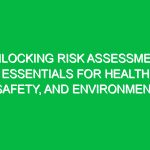Introduction
Hello, team! Thank you for gathering today for this important Toolbox Talk. Today, we’re going to discuss a critical topic that affects our Safety—especially during colder months: the Wind Chill Index. Understanding the Wind Chill Index is vital for our health and Safety in the workplace, particularly for those of us who work outdoors.
The Wind Chill Index is more than a number; it’s a crucial indicator that helps us assess the potential risks associated with cold weather conditions. By the end of this talk, you will not only know what the Wind Chill Index is but also how to apply this knowledge to maintain a safe working Environment.
What is the Wind Chill Index?
The Wind Chill Index is a measure that describes how cold it feels outside when the wind is factored in with the actual air temperature. Essentially, it combines the Effects of wind and temperature to give us a more accurate idea of how cold it really feels.
For instance, if the temperature is 30°F but the wind is blowing at 20 miles per hour, the Wind Chill Index could make it feel like it’s 15°F. This difference can have significant implications for our safety and health, particularly regarding frostbite and hypothermia.
The Science Behind Wind Chill
To understand the Wind Chill Index better, it’s essential to know how wind affects our perception of temperature. When it’s windy, it removes the warm layer of air that surrounds our body. This exposure to cold air can lead to a rapid drop in body temperature, increasing the risk of cold-related injuries.
The formula used to calculate the Wind Chill Index is based on several factors, including:
- Air temperature
- Wind speed
The result is a lower temperature than the actual air temperature, which indicates the risk level for cold-related health issues.
Why is the Wind Chill Index Important in HSE?
Understanding the Wind Chill Index is critical for several reasons:
- Prevention of Cold-Related Injuries: Knowing how cold it feels can help you take the necessary Precautions to prevent frostbite or hypothermia.
- Informed Decision Making: Awareness of the Wind Chill Index enables you to make informed decisions about whether it is safe to work outdoors.
- Compliance with Safety Regulations: Many Workplace Safety regulations require employers to consider environmental factors like wind chill when assessing Workplace Safety.
Recognizing the Risks
As we dive deeper into the Wind Chill Index, let’s explore the potential Hazards associated with it:
- Frostbite: This occurs when skin and underlying tissues freeze, often affecting fingers, toes, ears, and the nose. Symptoms include numbness and a pale appearance of the skin.
- Hypothermia: A life-threatening condition that occurs when the body loses heat faster than it can produce it. Symptoms include shivering, confusion, and fatigue.
- Reduced Work Efficiency: Cold temperatures can impair physical performance and concentration, leading to accidents or injuries.
How to Calculate the Wind Chill Index
Let’s talk about how you can calculate the Wind Chill Index. Here’s a simple formula to follow:
1. **Obtain the air temperature in degrees Fahrenheit.**
2. **Measure the wind speed in miles per hour.**
3. **Use the Wind Chill Index formula:**
Wind Chill Index = 35.74 + 0.6215(T) – 35.75(V^0.16) + 0.4275(T)(V^0.16)
Where:
– T = air temperature
– V = wind speed
While this formula can be used for a more precise calculation, there are also many online calculators and charts available that quickly give you the Wind Chill Index based on the temperature and wind speed.
Best Practices for Staying Safe in Cold Conditions
Now that we understand what the Wind Chill Index is, let’s discuss some Best Practices for staying safe in cold weather:
- Dress Appropriately: Wear layers of clothing to trap heat. Insulated gloves, hats, and face coverings are essential in windy conditions.
- Monitor the Weather: Always check the Wind Chill Index before heading to work. If the index indicates extreme cold, consider rescheduling outdoor tasks.
- Take Breaks: If you must work outside, take frequent breaks in a warm area to prevent exposure to the cold.
- Stay Hydrated: It’s easy to forget to drink water in cold weather, but staying hydrated helps maintain body heat.
Real-Life Scenarios
Let’s consider a couple of scenarios to illustrate the importance of the Wind Chill Index:
- Scenario 1: Imagine you are working outdoors and the temperature is 25°F with winds at 25 mph. The Wind Chill Index indicates it feels like 10°F. Without proper gear, you could be at risk for frostbite within 30 minutes.
- Scenario 2: You’re scheduled to work outside for several hours, but the Wind Chill Index indicates dangerous conditions. It’s crucial to communicate with your supervisor and potentially reschedule the task for a safer time.
Company Policies and Regulations
It’s critical to understand that our company has specific policies regarding outdoor work in cold weather. These policies are in place to ensure your safety. Familiarize yourself with the following:
- Cold Weather Safety Policy: This outlines the Procedures for monitoring the Wind Chill Index and taking appropriate actions.
- Emergency Procedures: Know the steps to take if someone shows signs of frostbite or hypothermia.
Adhering to these policies is not just good practice; it’s a legal obligation to ensure a safe working environment.
Engagement and Discussion
Before we wrap up, let’s open the floor for discussion:
- How many of you have experienced cold-related issues on the job?
- What strategies do you use to stay warm and safe while working outdoors?
- Do you feel equipped to assess the Wind Chill Index, and what resources would help you feel more prepared?
Your experiences and insights can greatly enhance our collective understanding and preparedness.
Conclusion
In conclusion, understanding the Wind Chill Index is essential for ensuring our safety while working in cold environments. By being aware of how wind and temperature interact, we can take the necessary Precautions to prevent cold-related injuries. Remember to dress appropriately, monitor the Weather regularly, and communicate with your team about any concerns regarding outdoor work.
Thank you for your attention today. Your commitment to safety is vital in maintaining a safe working environment for everyone. Let’s continue to look out for one another and ensure that we’re all prepared for the challenges that come with colder weather.


